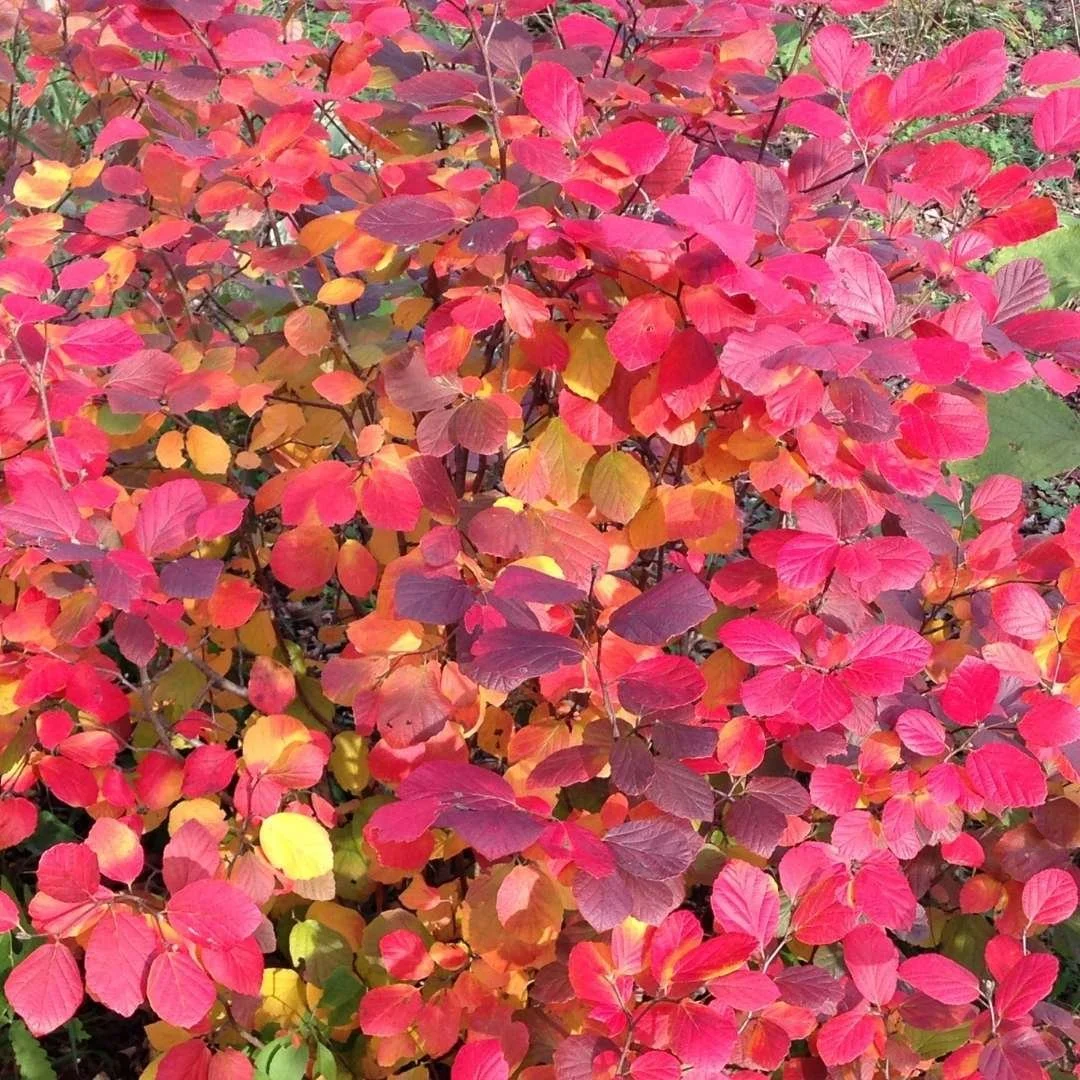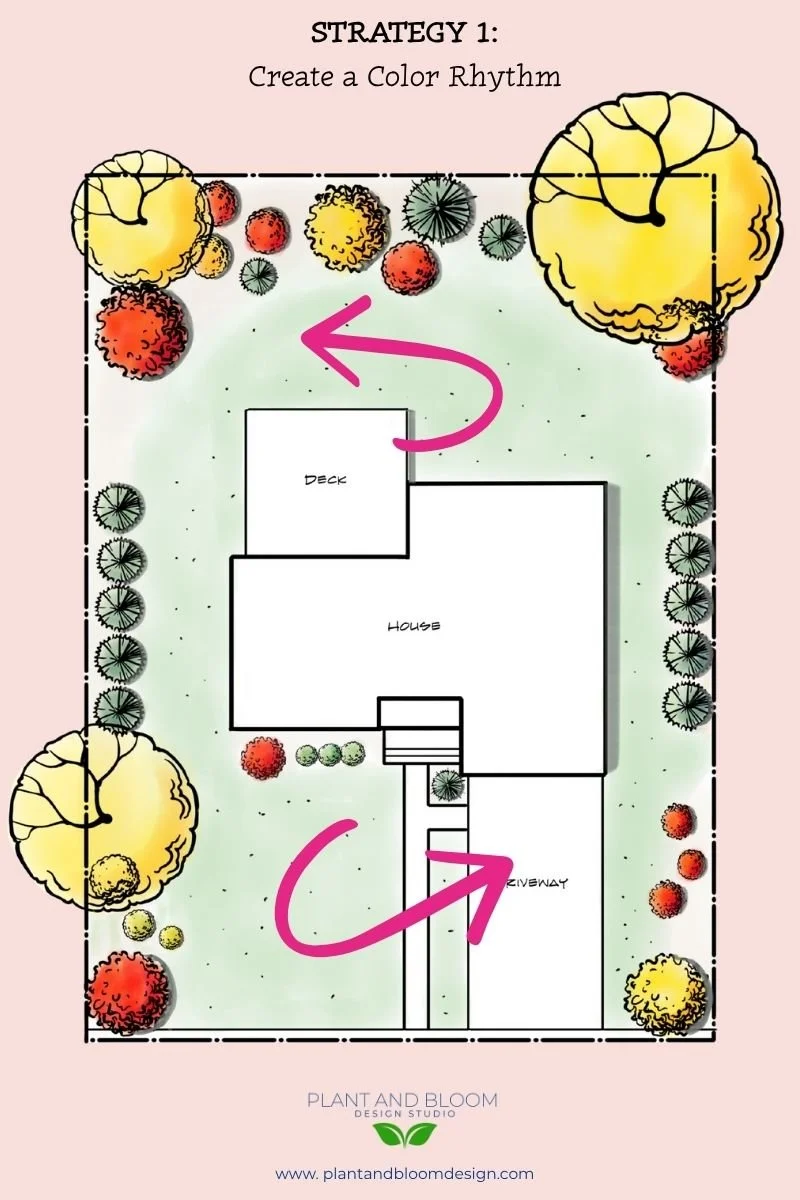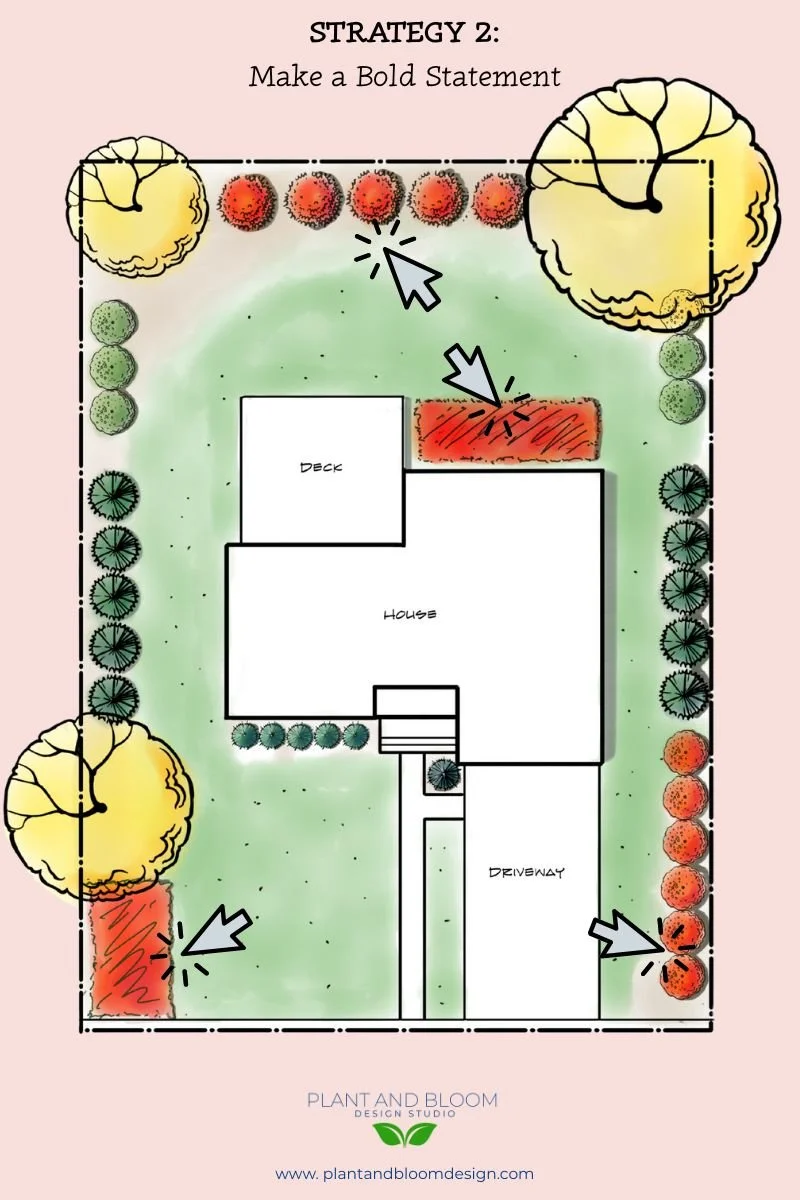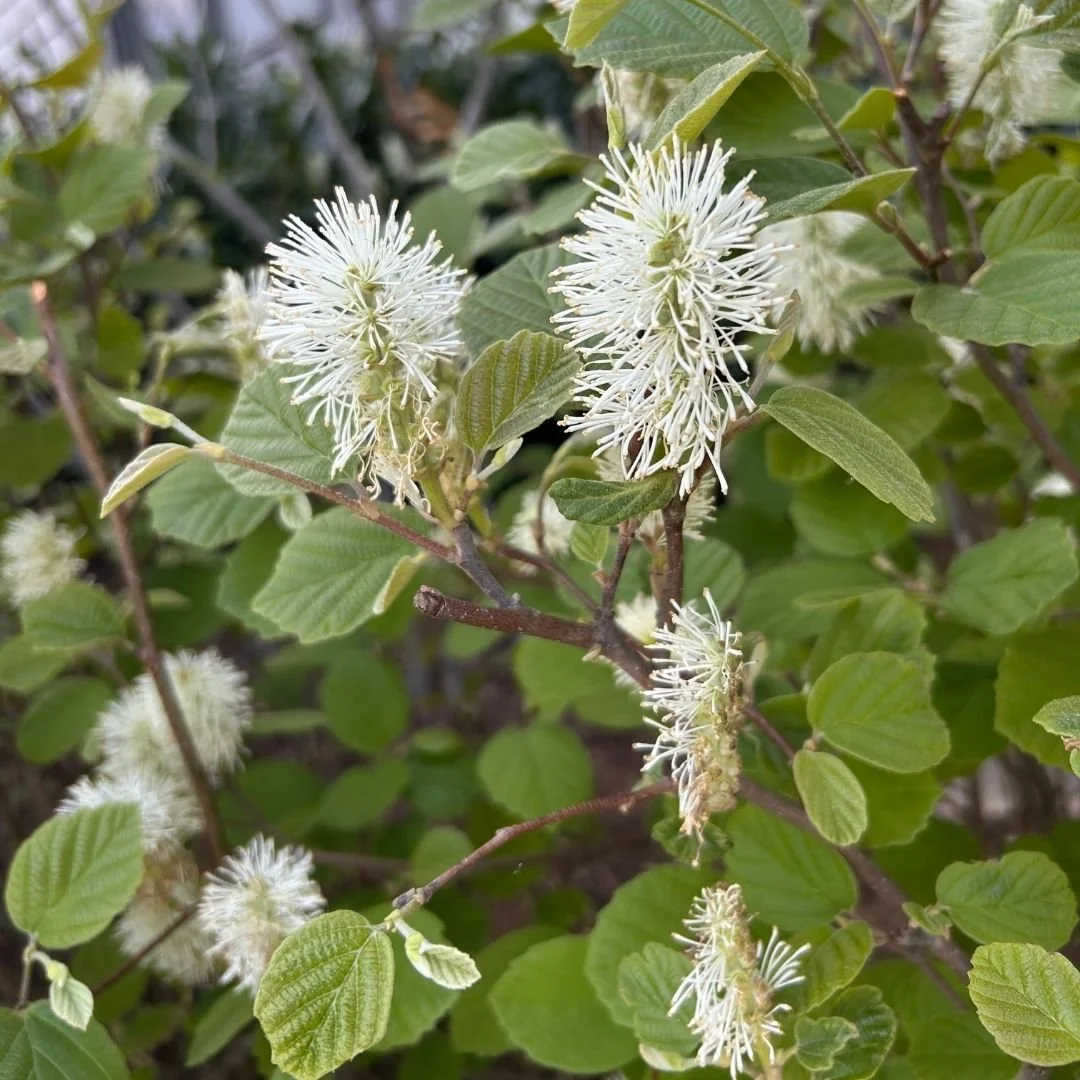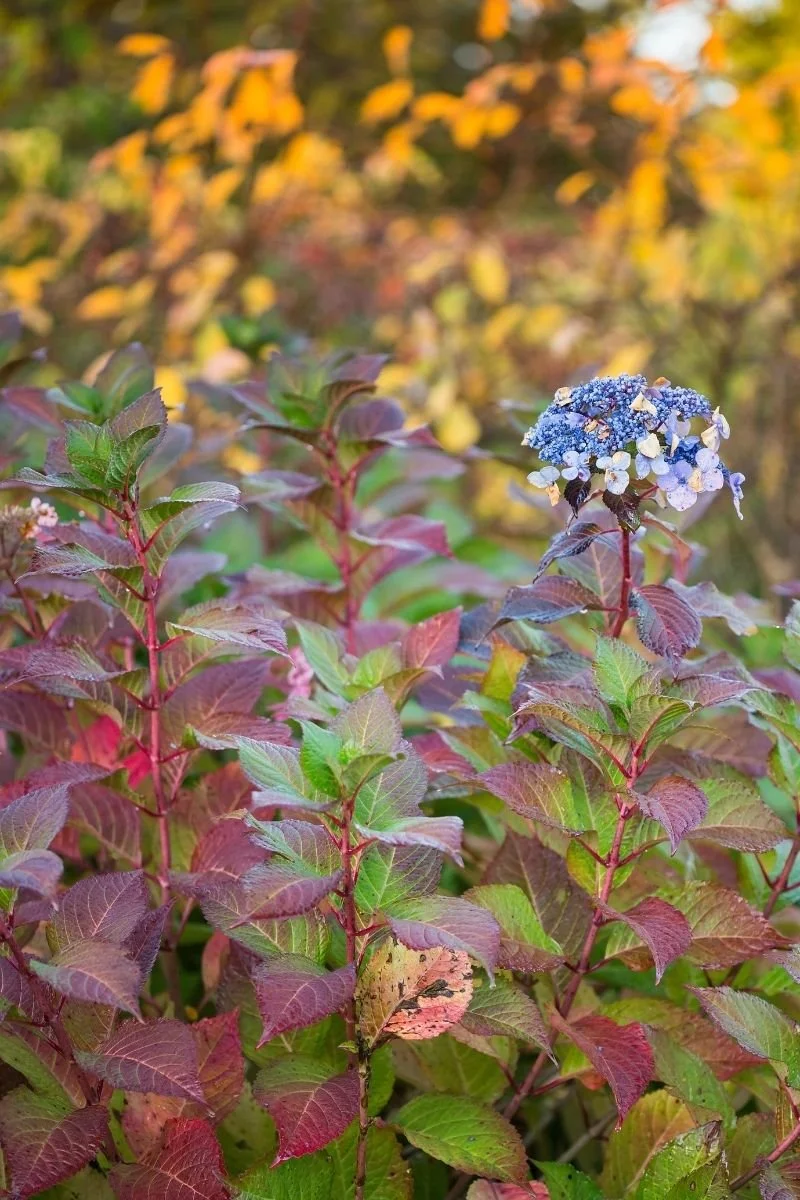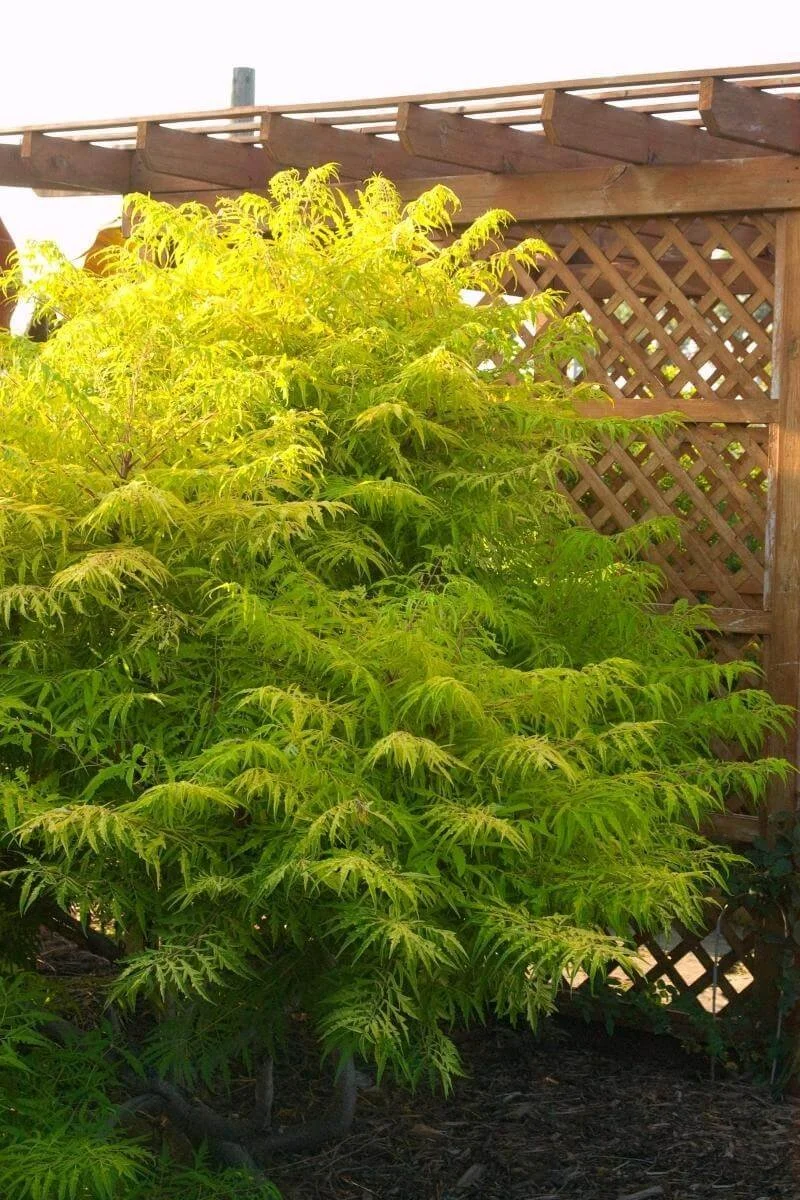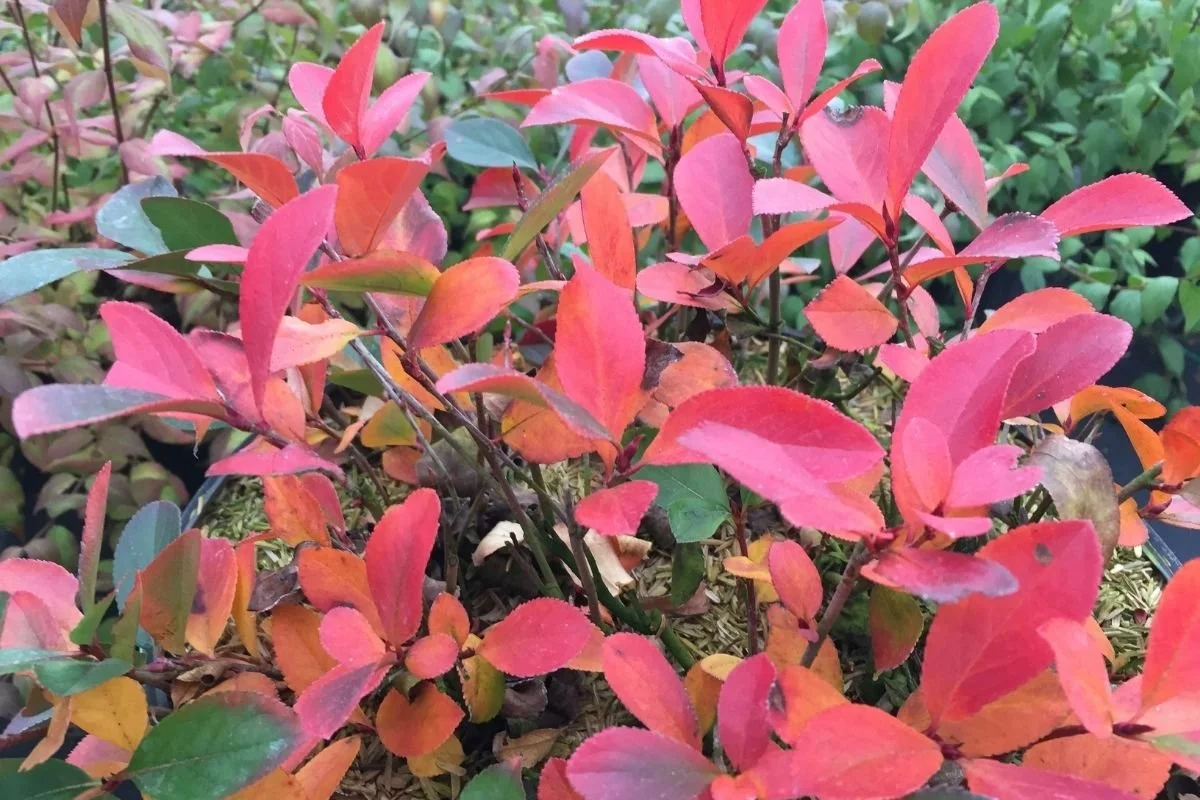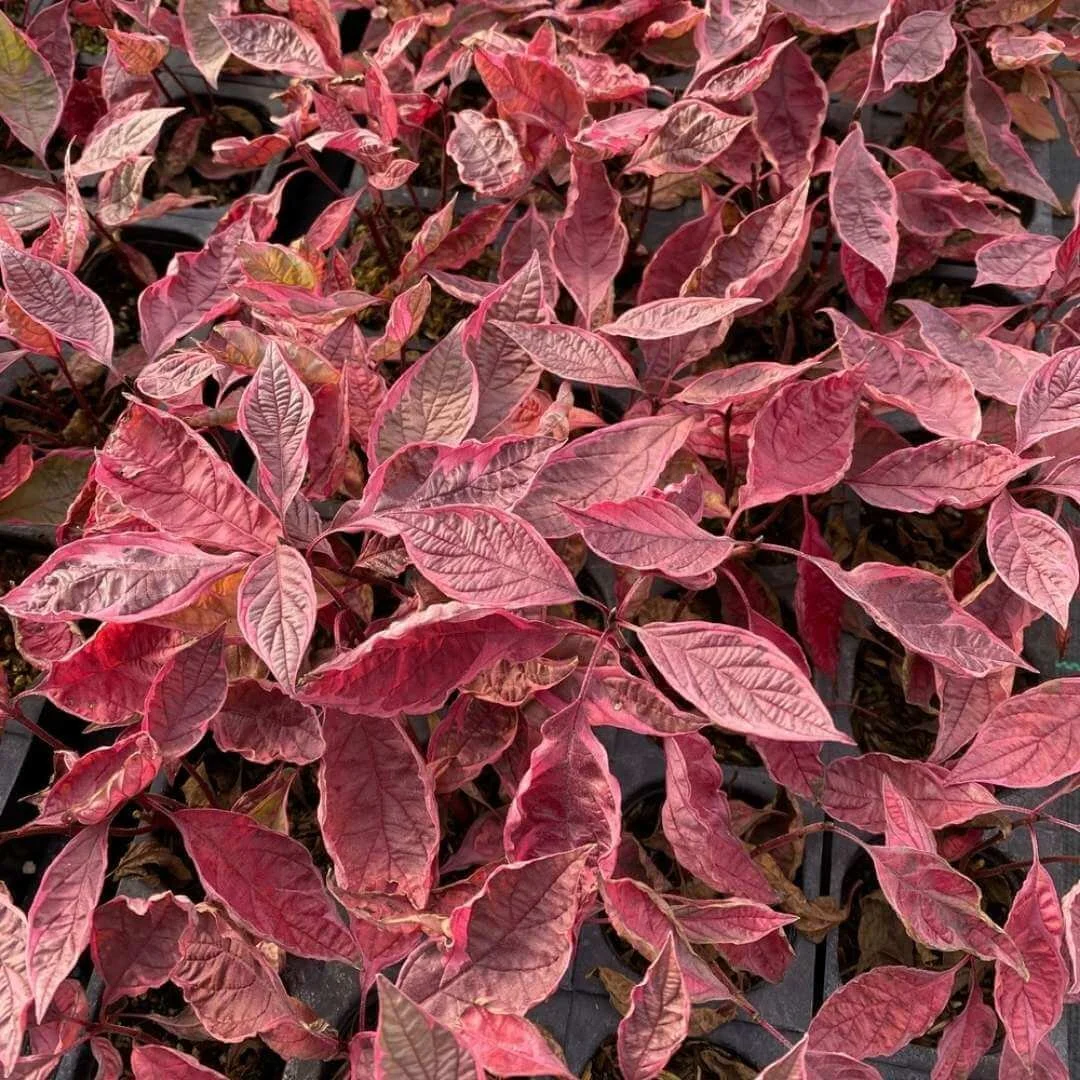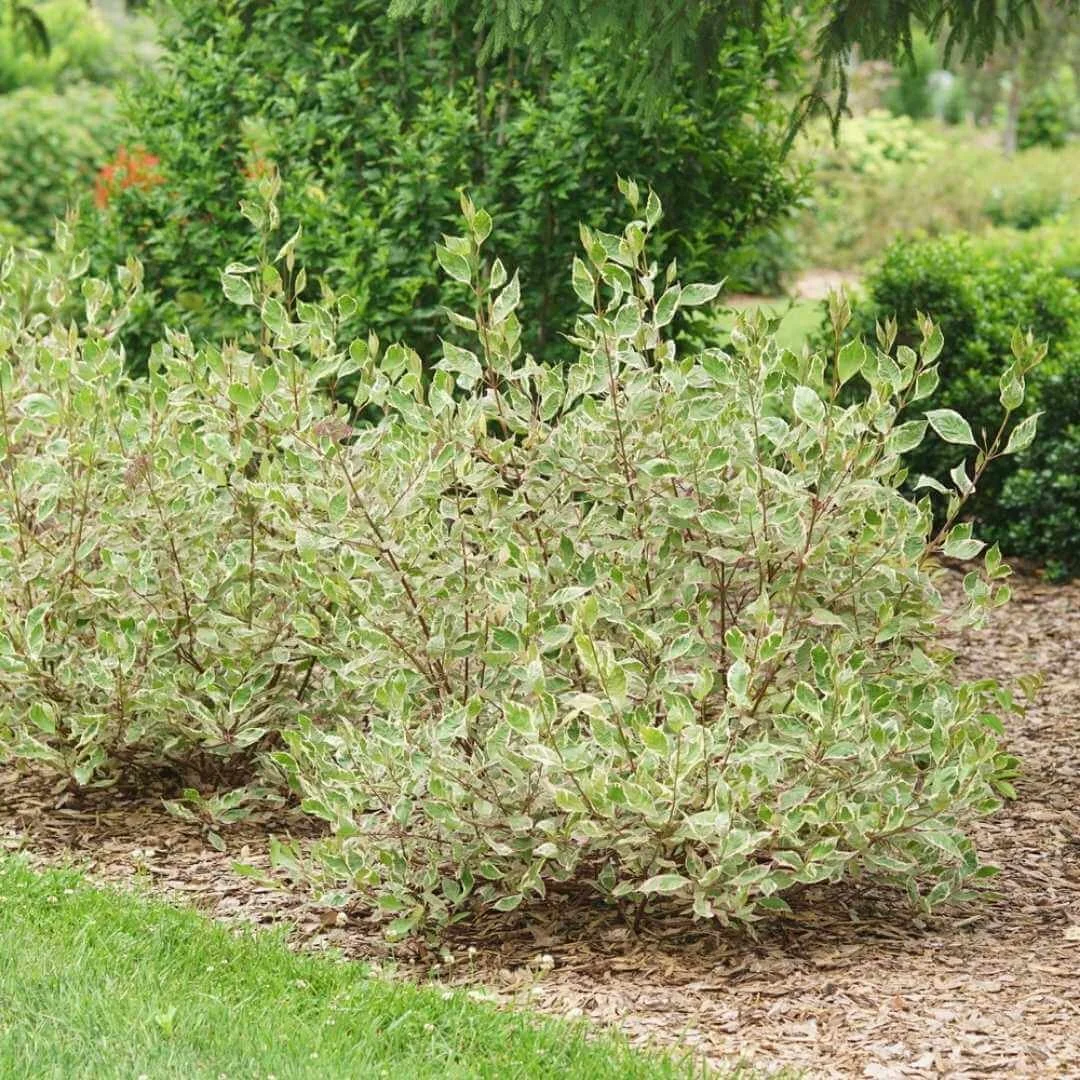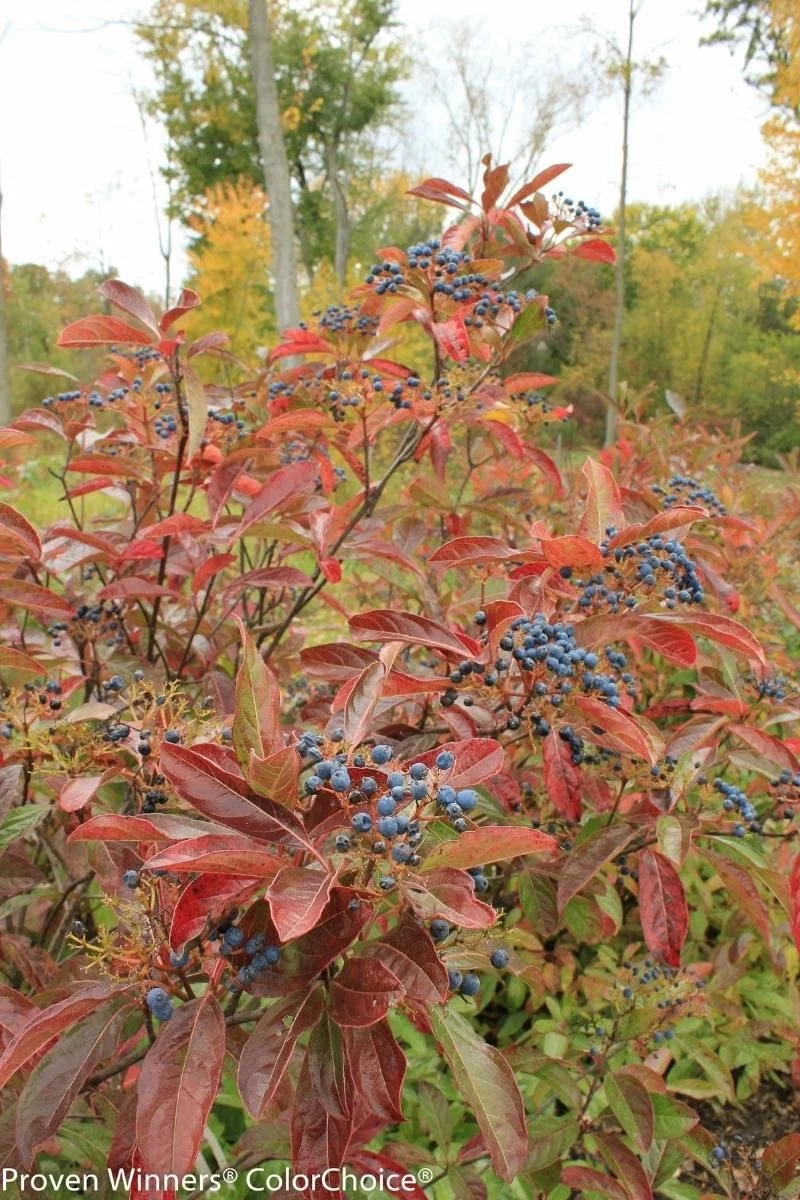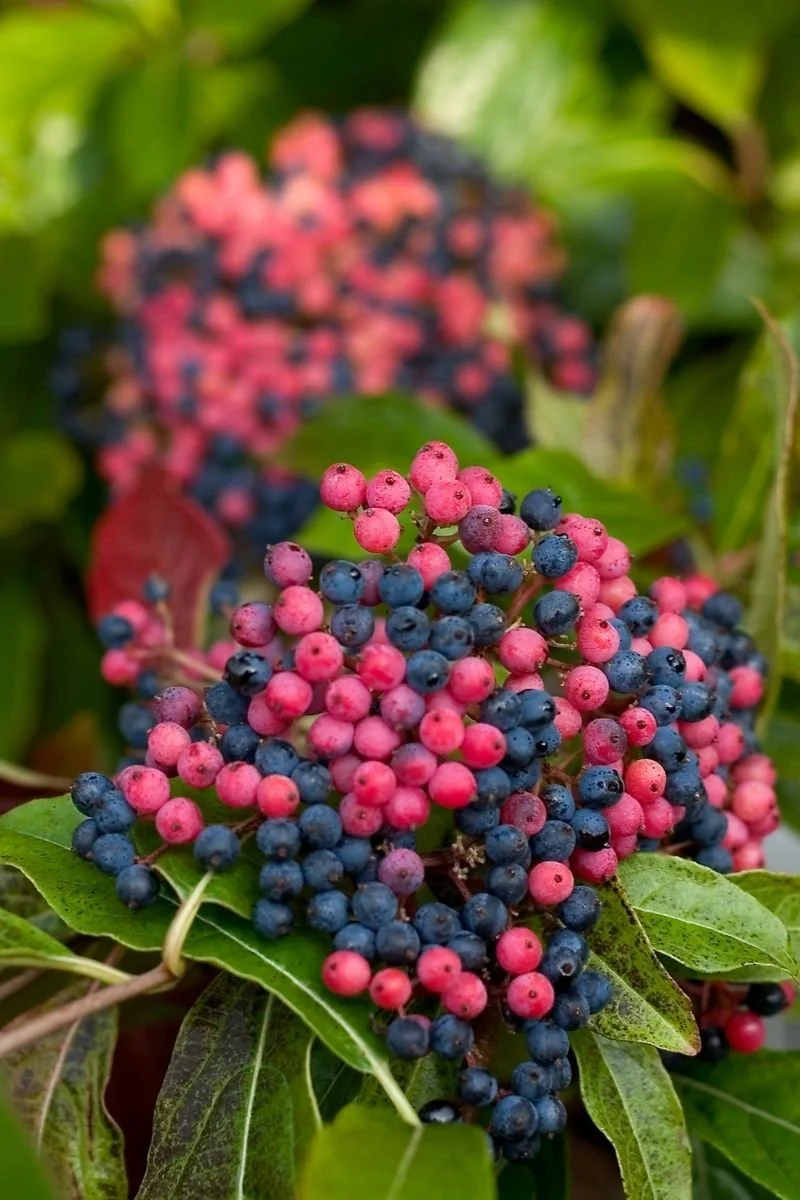10 Brilliant Bushes that Turn Red in the Fall
Want Stunning Bushes for Fall Color?
Here’s a list of 10 bushes with red fall color and two landscape design strategies to make your yard shine.
This post contains affiliate links, marked with an asterisk (*). If you click the link, I may receive a small commission at no extra cost to you - please see my policy on affiliate links. Thank you for supporting this blog!
Fall is easily one of the most beautiful seasons, and I always encourage my clients to fully embrace it - not just with pumpkins on the porch but also with gorgeous, natural bursts of color right in their planting beds. One of my favorite ways to do this is with bushes that turn red in fall.
When you pick the right shrubs, they bring vibrant, attention-getting color that turns an ordinary yard into a showstopper. The brilliant reds, fiery scarlets, and warm burgundies really pop against evergreen backdrops or fading grasses, making your yard a delight to come home to and a joy to look at from the window.
Today I’m sharing 10 of my favorite bushes for fall color - all of them reliable, beautiful, and guaranteed to add that extra spark of seasonal magic. Plus, I’ll explain two simple but powerful design strategies I use all the time when I’m asked what bushes turn red in fall and how best to plant them.
Legend of the Fall® fothergilla shrub (see #1 on this list). Image courtesy of Spring Meadow Nursery, Inc. via Proven Winners, provenwinners.com.
Why Plant Bushes That Turn Red in Fall?
So many homeowners focus all their planting energy on spring and summer blooms, but fall deserves its moment in the spotlight too. Bushes that turn red in fall bring instant drama and draw the eye right towards where you want it.
They’re perfect for adding a dynamic layer at the low to mid-layers of your landscape, and a smart way to keep your yard interesting at eye level when summer blooms are gone.
You can use these shrubs to build rhythm throughout your yard or make one big, bold statement - two design strategies I’ll break down for you next. But first, keep a few basics in mind:
Hardiness Zones: Always check that a shrub is suited for your gardening zone. If you don’t know what zone you are in, check the USDA zone map.
Sunlight Needs: Some bushes prefer full sun, others thrive in part shade. It’s helpful to remember these definitions:
Watering: Newly planted bushes need consistent watering, especially during autumn heat waves. Keep watering until your plants drop their leaves and go fully dormant, and check local drought updates with the US Drought Monitor map.
Leaf Cleanup: Be gentle when clearing fallen leaves. Leaf blowers can damage tender branches or strip leaves prematurely, especially on young plants. It’s best to gently shake off excess leaves and rake by hand around newly planted shrubs.
Low Scape Mound® aronia (see #7 on this list). Image courtesy of Proven Winners, provenwinners.com
Two Landscape Design Strategies for Using Bushes with Red Fall Color
Now, let’s talk about how you can actually use these bushes that turn red in fall to get the biggest visual payoff. Here are my two favorite design strategies:
1. Create a Color Rhythm
If you want to know what bushes turn red in fall and how to arrange them naturally, here’s your answer: stagger them around the yard to create a rhythm. This draws the eye around the landscape in a pleasing, natural flow.
The idea is to plant them in odd-numbered groups - think 1, 3, 5, or even 7 - and avoid planting in straight lines, so they look more organic and free-flowing. This style looks beautiful in mixed borders, woodland settings, or naturalistic plantings alongside evergreens and yellow or orange fall shrubs.
For example, try planting several red fall bushes along your backyard fence and weaving in other colorful shrubs and evergreens for year-round interest. The effect is harmonious yet informal, giving your yard an effortless, laid-back feeling that echoes the beauty of nature.
2. Make a Bold Statement
The other strategy is all about drama: plant multiples of the same type of shrub together so the red color creates one big impact. This works well for front yard beds, informal hedges, or anywhere you want an eye-catching focal point, like around a patio, driveway, or deck.
Picture a wide bed of vibrant red bushes glowing when the low autumn sun hits them. Or a row of shrubs along your driveway welcoming you home with a burst of fiery foliage.
The idea is to mass enough plants together to blanket a space in vivid red. It’s my favorite way to make a landscape pop, whether you’re admiring it from the street or through your living room window. I rely on this strategy whenever a client wants their fall color to really catch the eye from the curb or indoors.
10 Bushes That Turn Red in Fall - My Top Picks
Ready to add some red to your yard? Here are 10 standout bushes for fall color, complete with tips to help you choose the right one for your space.
1. Fothergilla
Fothergilla gardenii
Zones: 5 - 8
Light: Full sun to part shade
Size: 2 - 4 feet high and wide
Deer Resistant: Yes
The brilliant red fall foliage of fothergilla.
If you love a shrub that looks great all season, dwarf fothergilla should be high on your list of bushes that turn red in fall. Native to the Southeastern United States, this slow-growing deciduous shrub is a real multi-tasker in the landscape.
In spring, it produces fluffy, fragrant white bottlebrush flowers that smell amazing and attract early pollinators. Through summer, its soft green foliage stays tidy and appealing.
Come fall, dwarf fothergilla’s leaves transform into brilliant shades of red, often mixed with orange, yellow and purple, giving you a rich, warm tapestry of color. It’s perfect for creating a rhythmic flow when planted in drifts or groups in woodland gardens and shrub borders. You can also mass fothergilla to make a low hedge that brings eye-level interest where you want it most.
Soft green leaves and fragrant, bottlebrush flowers give fothergilla its spring charm.
Fothergilla thrives in moist, rich soil and appreciates afternoon shade in hotter climates. Deer tend to leave it alone, and its low-maintenance nature makes it an easy plant for beginners.
If you’re a native gardener, stick with the straight species. If you want something a little different, try popular cultivars like ‘Mount Airy,’ which grows taller and blooms heavily, or Legend of the Fall®, known for its intense autumn color. ‘Blue Mist’ and ‘Blue Shadow’ have striking silvery blue foliage that turns brilliant red in autumn. All of these are gorgeous options for bringing fiery fall color to your yard!
2. Ginger Wine® Ninebark
Physocarpus opulifolius 'SMNPOBLR'
Zones: 3 - 7
Light: Full sun
Size: 5 - 6 feet high and wide
Deer Resistant: Yes (protect young plants)
Ginger Wine Ninebark looks stunning year-round. Image courtesy of Spring Meadow Nursery, Inc. via Proven Winners, provenwinners.com.
When people ask me what bushes turn red in the fall, yet still look striking the rest of the year, Ginger Wine® ninebark is one I recommend again and again. This low maintenance shrub delivers vibrant color, starting in springtime when fresh leaves emerge a bright orange, then mature into a rich, burgundy red.
In late spring and early summer, Ginger Wine® ninebark blooms with clusters of pinkish-white flowers that contrast beautifully with its dramatic foliage. Come autumn, the foliage deepens in color, blending shades of purple, red, and warm orange that look stunning when backlit by afternoon sun.
The peeling bark of ninebark adds beautiful texture and visual interest to the winter landscape when the leaves are gone.
Ginger Wine ninebark flowers in late spring and early summer. Image courtesy of Spring Meadow Nursery, Inc. via Proven Winners, provenwinners.com.
Keep its mature size in mind - ninebark is a medium to large shrub with a naturally arching, cascading shape. Give it plenty of space, or its branches will eventually spill over and cascade onto nearby plants. It works beautifully as a specimen, focal point, or mass planting.
It’s also deer resistant, loves full sun and will tolerate clay soil and short periods of drought. Use Ginger Wine® ninebark in mixed borders, as 3-season screening, or to anchor the corner of a large bed where its red fall color can shine.
3. Endless Summer® Twist-n-Shout® Reblooming Hydrangea
Hydrangea macrophylla ‘PIIHM-I’
Zones: 4 - 9
Light: Part shade
Size: 3 - 5 feet tall and 3 - 4 feet wide
Deer Resistant: No
If you want bushes for fall color and bold, beautiful blooms, Twist-n-Shout® hydrangea is a double win. This cultivated bigleaf hydrangea combines the iconic lacecap hydrangea flower shape with an added bonus: vibrant red stems and fantastic fall foliage.
The Twist-n-Shout® hydrangea has red stems and vibrant fall color. Image courtesy of Bailey Nurseries.
In summer, you’ll enjoy its showy blooms - either periwinkle blue or deep pink depending on your soil’s pH. As temperatures drop, the deep green serrated leaves put on an encore performance, turning bold shades of red, burgundy, and deep purple. The stems maintain their vivid red color, adding to the multi-season show.
Twist-n-Shout® hydrangea flowers are pink or blue, depending on soil pH. Image courtesy of Bailey Nurseries.
This hydrangea is incredibly versatile. Use it in foundation plantings, along woodland edges, or in mixed borders where its blooms and foliage can really stand out. It also works well massed for a big splash of color. For more growing and care tips, check out our full article on Twist-n-Shout® hydrangeas.
A Twist-n-Shout® hydrangea with blue lacecap flowers. Image courtesy of Bailey Nurseries.
4. First Editions® Tiger Eyes® Cutleaf Staghorn Sumac
Rhus typhina 'Bailtiger'
Zones: 4 - 8
Light: Full sun
Size: 6 feet high and wide
Deer Resistant: No
The brilliant scarlet red fall leaves of First Editions® Tiger Eyes® cutleaf staghorn sumac. Image courtesy of Bailey Nurseries.
If you crave dramatic color and a plant with a touch of wild beauty, staghorn sumac is one of the most striking bushes that turn red in fall. This native deciduous shrub is famous for its upright, mounded shape and showy, feather-like foliage that blazes scarlet red to intense orange hues in autumn.
The First Editions® Tiger Eyes® Cutleaf Staghorn Sumac has striking fall color. Image courtesy of Bailey Nurseries.
In spring and summer, staghorn sumac produces greenish-yellow flowers and new chartreuse foliage that turns yellow as the season progresses. Fuzzy, bright red fruit clusters follow, lasting into winter to feed birds and add a bold accent to your yard. This plant tolerates poor soils, drought, erosion, and even black walnut trees, making it incredibly tough and adaptable.
First Editions® Tiger Eyes® Cutleaf Staghorn Sumac. Image courtesy of Bailey Nurseries.
If you’ve always thought of sumac as weedy or too aggressive, let me change your mind - ‘Tiger Eyes’ is a whole different story. While it does spread slowly by suckers, it’s far from aggresive like some other sumac types. Try it as a bold specimen, an eye-catching accent, or planted in a loose, naturalistic groups on a dry and sunny slope.
5. Scentlandia® Sweetspire
Itea virginica 'SMNIVDFC'
Zones: 5 - 9
Light: Full sun to full shade
Size: 2 - 3 feet high and wide
Deer Resistant: Yes
When space is tight but you still want bushes for fall color, look no further than Scentlandia® Virginia sweetspire. This compact deciduous shrub packs a punch. It stays around 2-3 feet tall and wide, fitting nicely into small beds, foundation plantings, or rain gardens.
The vivid red and purple hues of Scentlandia® sweetspire light up the autumn garden. Image courtesy of Spring Meadow Nursery, Inc via Proven Winners, provenwinners.com
In late spring to early summer, Scentlandia® bursts with fragrant white flowers that attract butterflies and pollinators. In fall, its foliage transforms into brilliant shades of red, purple, and orange, creating a vibrant display that lights up shady corners where other shrubs might struggle.
One of the most shade-tolerant flowering shrubs you’ll find, sweetspire can handle heavy shade, erosion, clay soil, and even wet spots. It’s an excellent choice for native gardens, pollinator gardens, and mixed borders. For maximum effect, plant it in groups for a dramatic sweep of color and scent.
Scentlandia® sweetspire has fragrant white flowers. Image courtesy of Spring Meadow Nursery, Inc via Proven Winners, provenwinners.com
* Dig into your next great gardening read while supporting independent bookstores - browse my favorite picks on Bookshop.org! *
6. Sweet Emotion Blaze™ Hardy Abelia
Abelia mosanensis 'SMNAMW'
Zones: 4 - 8
Light: Full sun
Size: 5 - 6 feet high and 4 - 6 feet wide
Deer Resistant: Yes
A fiery fall display from Sweet Emotion Blaze™ hardy abelia. Image courtesy of Spring Meadow Nursery, Inc. via Proven Winners, provenwinners.com
Sweet Emotion® Blaze™ abelia puts a fresh spin on bushes that turn red in fall by offering three seasons of beauty in one easy-care shrub. This deciduous variety reaches 5-6 feet tall and wide, making it the perfect choice for mixed borders and deciduous screening.
In spring, Sweet Emotion® Blaze™ shows off fragrant pink blooms that attract butterflies and bees. As summer progresses, its green foliage stays lush and tidy and when fall arrives, the show kicks up a notch: leaves turn fiery shades of red and orange, adding a brilliant glow to your landscape.
Unlike evergreen abelias, this one drops its leaves for winter, so plan accordingly if using it as a hedge. It’s a standout pick for shrub borders, foundation beds, or anywhere you’d like a fragrant, colorful, low maintenance plant.
7. Low Scape Mound® Aronia
Aronia melanocarpa 'UCONNAM165'
Zones: 3 - 9
Light: Full sun to part shade
Size: 1 - 2 feet high and 3 - 4 feet wide
Deer Resistant: No
Low Scape Mound® aronia red fall color. Image courtesy of Proven Winners, provenwinners.com
Need a hardy, low-maintenance bush that turns red in fall and fits anywhere? Meet Low Scape Mound® aronia. This compact deciduous shrub tops out at just about 2 feet tall, making it an excellent choice for small gardens, groundcover beds, or as a deciduous lawn alternative.
Low Scape Mound® aronia is a tidy, low-growing ground cover shrub. Image courtesy of Proven Winners, provenwinners.com
It starts the season off with dainty white flowers that attract pollinators, while its glossy green foliage stays handsome all summer long. When fall arrives the leaves blaze bright red, and clusters of dark purple berries appear, feeding the birds and providing a beautiful contrast with the brilliant foliage.
Low Scape Mound® is adaptable and tough, handling wet soil and a variety of different growing conditions including salt and urban environments. Use it in mass plantings, at the front of the house, or for erosion control. If you want low effort but big impact, this little aronia shrub is a winner.
8. Ruby Slippers Oakleaf Hydrangea
Hydrangea quercifolia ‘Ruby Slippers’
Zones: 5 - 9
Light: Full sun to part shade
Size: 3 - 4 feet high and 4 - 5 feet wide
Deer Resistant: No
In fall, Ruby Slippers showcases oak-shaped leaves in stunning burgundy and red tones.
Few shrubs offer four seasons of interest quite like the Ruby Slippers oakleaf hydrangea. This compact variety of oakleaf hydrangea is a standout with its large, deeply lobed leaves that mimic oak tree foliage - gorgeous green in summer, then turning bold mahogany-red in fall.
In early summer, it produces upright white flower clusters that quickly age to deep pink, adding yet another layer of color and interest. In winter, its cinnamon-colored peeling bark provides texture and visual appeal long after the leaves have fallen.
Native to the Southeastern United States, Ruby Slippers thrives in moist, well-draining soil and does beautifully planted along woodland edges, around a fire pit, as part of a foundation planting, or as an informal hedge. For more ideas, read our article about the Ruby Slippers hydrangea.
Ruby Slippers Hydrangea flowers emerge white in spring.
9. Sgt. Pepper® Dogwood
Cornus alba 'Verpaalen2'
Zones: 3 - 7
Light: Full sun to part shade
Size: 4 - 6 feet high and 6 - 8 feet wide
Deer Resistant: Yes
Sgt. Pepper® Dogwood leaves turn shades of red and deep pink in fall. Image courtesy of Spring Meadow Nursery, Inc. via Proven Winners, provenwinners.com
If you’re looking for a versatile shrub with striking red fall color, Sgt. Pepper® dogwood is a standout choice. This easygoing deciduous shrub adds multi-season interest with its eye-catching variegated foliage and clusters of white flowers in late spring. From spring through fall, it has green leaves edged with white and hints of pink, brightening up beds and borders long before the brilliant autumn show begins.
Come fall, Sgt. Pepper® lights up the garden as leaves shift to rich shades of red and pink, delivering a bold splash of color in the fall garden. Even after the leaves drop, its vibrant burgundy stems add subtle winter interest and look especially striking when poking up through a fresh blanket of snow.
This dogwood shrub is hardy, adaptable, and easy to grow - a perfect pick for beginners and seasoned gardeners alike! It handles a range of soil conditions, tolerates wet spots, and thrives in full sun to part shade. Just keep its mature size in mind and give it enough space to shine. With colorful foliage, vivid fall color, and low-maintenance care, Sgt. Pepper® dogwood is an easy way to bring lasting beauty and seasonal drama to your landscape.
Sgt. Pepper® Dogwood shows off colorful variegated leaves and striking red stems in spring. Image courtesy of Spring Meadow Nursery, Inc. via Proven Winners, provenwinners.com
10. Brandywine™ Viburnum
Viburnum nudum 'Bulk'
Zones: 5 - 9
Light: Full sun to part shade
Size: 5 - 6 feet high and wide
Deer Resistant: Yes
Brandywine™ viburnum dazzles with vibrant red fall foliage and glossy blue berries. Image courtesy of Proven Winners, provenwinners.com
If you want bushes for fall color that also support wildlife, Brandywine™ viburnum is an all-star choice. This deciduous shrub produces fragrant white flowers in spring, which develop into glossy berries that shift from green to pink to dark blue - a treat for birds and a pop of color for you.
When autumn arrives, the foliage turns dramatic shades of deep red to purple, often at the same time the berries are ripening. This double show makes Brandywine™ a gorgeous addition to hedges, woodland edges, rain gardens, fence lines, and mixed borders.
It’s tough, low maintenance, and can handle medium to wet soils. Plant it where you can enjoy its multi-season display up close! It’s especially nice near patios, side yards, or planted in bird gardens where the wildlife action adds extra life to your landscape.
Brandywine™ viburnum’s bright pink and blue berries are a favorite snack for cardinals and mockingbirds when they ripen in fall. Image courtesy of Proven Winners, provenwinners.com
Ready to Add Some Red to Your Yard?
Fall is your chance to add a whole new layer of beauty to your landscape, and these bushes that turn red in fall are the perfect way to do it. Whether you prefer to scatter them for a subtle, rhythmic effect or plant them in bold masses for a dramatic focal point, you can’t go wrong with any of these options.
Take a little time to check your zones, match your sunlight levels, and think through where you’d love to see that pop of vibrant red when the rest of the garden starts to wind down. With just a bit of planning, you’ll enjoy an autumn landscape that turns heads and lifts your spirits year after year.
Happy planting - and enjoy the fall color show!
Follow Plant and Bloom Design Studio on Pinterest for more garden ideas!
The 10 Best Fall Blooming Perennials for Autumn Beauty
Clockwise from left: Superbells® Blue Callibrachoa, Gigi™ Orange Garden Mum, Goldilocks Creeping Jenny. Image courtesy of Proven Winners, provenwinners.com

